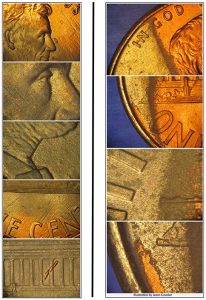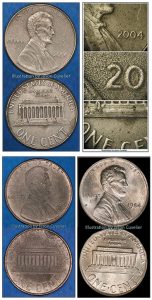Diagnostics of Fake and Genuine Unplated Zinc Cents
by Jason Cuvelier
While searching bank rolls, one can find three common types of altered unplated Lincoln’s. The first two types having the plating removed: a Lincoln soaked in a corrosive; a Lincoln subjected to some type of reverse electrolysis; the last is when a Lincoln has been plated on top of the original copper plating. Following are some shots of various altered or fake unplated Lincoln cents that had the plating removed along with photos of genuine examples.
Partial unplated Lincoln cent. Genuine 1995 (left) and the plating removed by electrolysis is 1995 (right). Black arrows show the different sheen observed to the surfaces. White arrow show the damaged surface of the unplated area. It exhibits linear valleys and small raised islands topped with copper. The reverse shows more extensive damage. The top white arrow is an existing plating blister that somehow remained. Surface characteristics of the coin on the right suggest the process of plating removal leaves evidence of the original plating issues such as split plating, areas of thinner plating and blisters. The three lower white arrows show the damaged surface of the unplated area.

This 2004 Lincoln was fully unplated by a chemical corrosive. It exhibits acid bite marks and a severe loss of detail. This particular example seems to have had the sides sanded and polished down.

1994 1c (left) unplated by reverse electrolysis. A more significant loss of zinc and details, but not as great as the corrosive damaged 2004 example. A few small areas of copper remain in the raised portions of outside devices.

1984 1c (right) with no evidence of the plating being stripped or the zinc being damaged. No copper islands or valleys of missing zinc exist. The coin still has a nice sheen and is underweight (2.43g). Keys areas show die flow lines.




